Leadership & Professional Development: Theories, Analysis, and Skills
VerifiedAdded on 2020/11/23
|19
|5733
|446
Report
AI Summary
This report provides a comprehensive overview of leadership and professional development, delving into various leadership theories. It begins by defining leadership and exploring its significance, followed by an examination of trait, behavioral, and contingency theories. The report analyzes the strengths, weaknesses, and implications of each theory, supported by relevant models and criticisms. A significant portion is dedicated to a critical analysis of transformational leadership, including its components, skill development steps, and associated criticisms. The report integrates figures and references to support its arguments, offering a well-structured and insightful exploration of leadership concepts and their practical applications. The report aims to enhance the understanding of leadership styles, their impact, and the development of effective leadership skills.
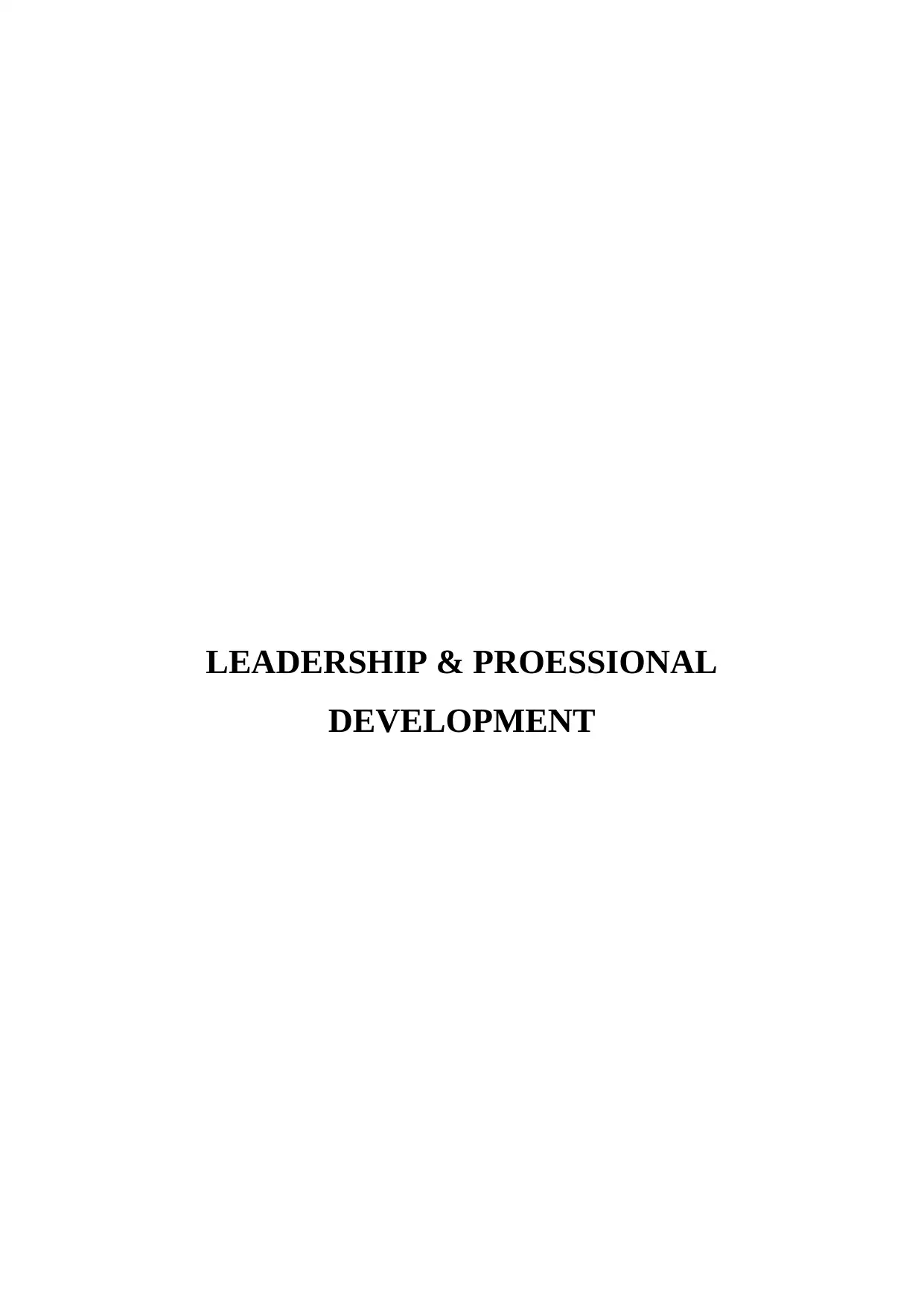
LEADERSHIP & PROESSIONAL
DEVELOPMENT
DEVELOPMENT
Paraphrase This Document
Need a fresh take? Get an instant paraphrase of this document with our AI Paraphraser
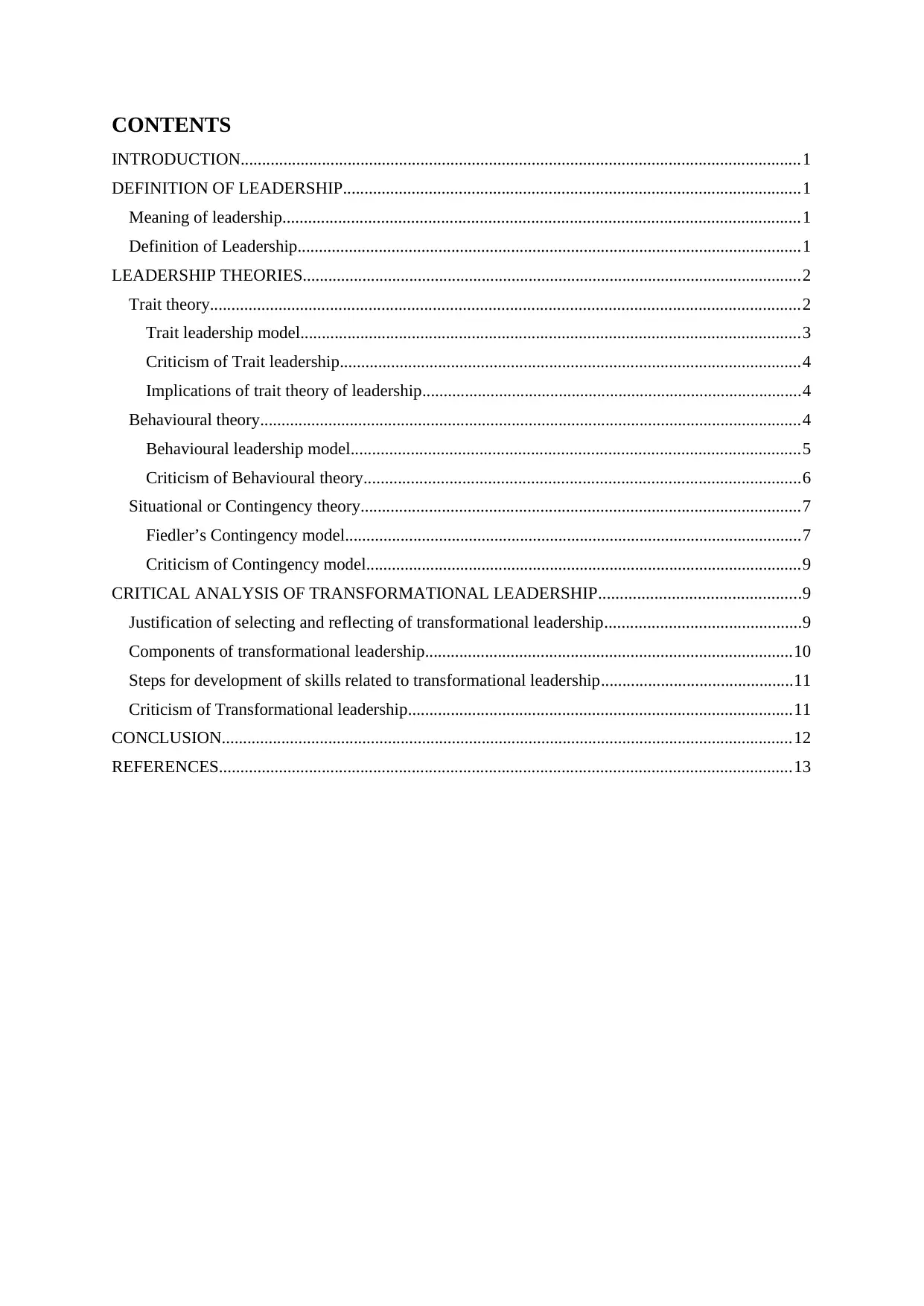
CONTENTS
INTRODUCTION...................................................................................................................................1
DEFINITION OF LEADERSHIP...........................................................................................................1
Meaning of leadership.........................................................................................................................1
Definition of Leadership......................................................................................................................1
LEADERSHIP THEORIES.....................................................................................................................2
Trait theory..........................................................................................................................................2
Trait leadership model.....................................................................................................................3
Criticism of Trait leadership............................................................................................................4
Implications of trait theory of leadership.........................................................................................4
Behavioural theory...............................................................................................................................4
Behavioural leadership model.........................................................................................................5
Criticism of Behavioural theory......................................................................................................6
Situational or Contingency theory.......................................................................................................7
Fiedler’s Contingency model...........................................................................................................7
Criticism of Contingency model......................................................................................................9
CRITICAL ANALYSIS OF TRANSFORMATIONAL LEADERSHIP...............................................9
Justification of selecting and reflecting of transformational leadership..............................................9
Components of transformational leadership......................................................................................10
Steps for development of skills related to transformational leadership.............................................11
Criticism of Transformational leadership..........................................................................................11
CONCLUSION......................................................................................................................................12
REFERENCES......................................................................................................................................13
INTRODUCTION...................................................................................................................................1
DEFINITION OF LEADERSHIP...........................................................................................................1
Meaning of leadership.........................................................................................................................1
Definition of Leadership......................................................................................................................1
LEADERSHIP THEORIES.....................................................................................................................2
Trait theory..........................................................................................................................................2
Trait leadership model.....................................................................................................................3
Criticism of Trait leadership............................................................................................................4
Implications of trait theory of leadership.........................................................................................4
Behavioural theory...............................................................................................................................4
Behavioural leadership model.........................................................................................................5
Criticism of Behavioural theory......................................................................................................6
Situational or Contingency theory.......................................................................................................7
Fiedler’s Contingency model...........................................................................................................7
Criticism of Contingency model......................................................................................................9
CRITICAL ANALYSIS OF TRANSFORMATIONAL LEADERSHIP...............................................9
Justification of selecting and reflecting of transformational leadership..............................................9
Components of transformational leadership......................................................................................10
Steps for development of skills related to transformational leadership.............................................11
Criticism of Transformational leadership..........................................................................................11
CONCLUSION......................................................................................................................................12
REFERENCES......................................................................................................................................13
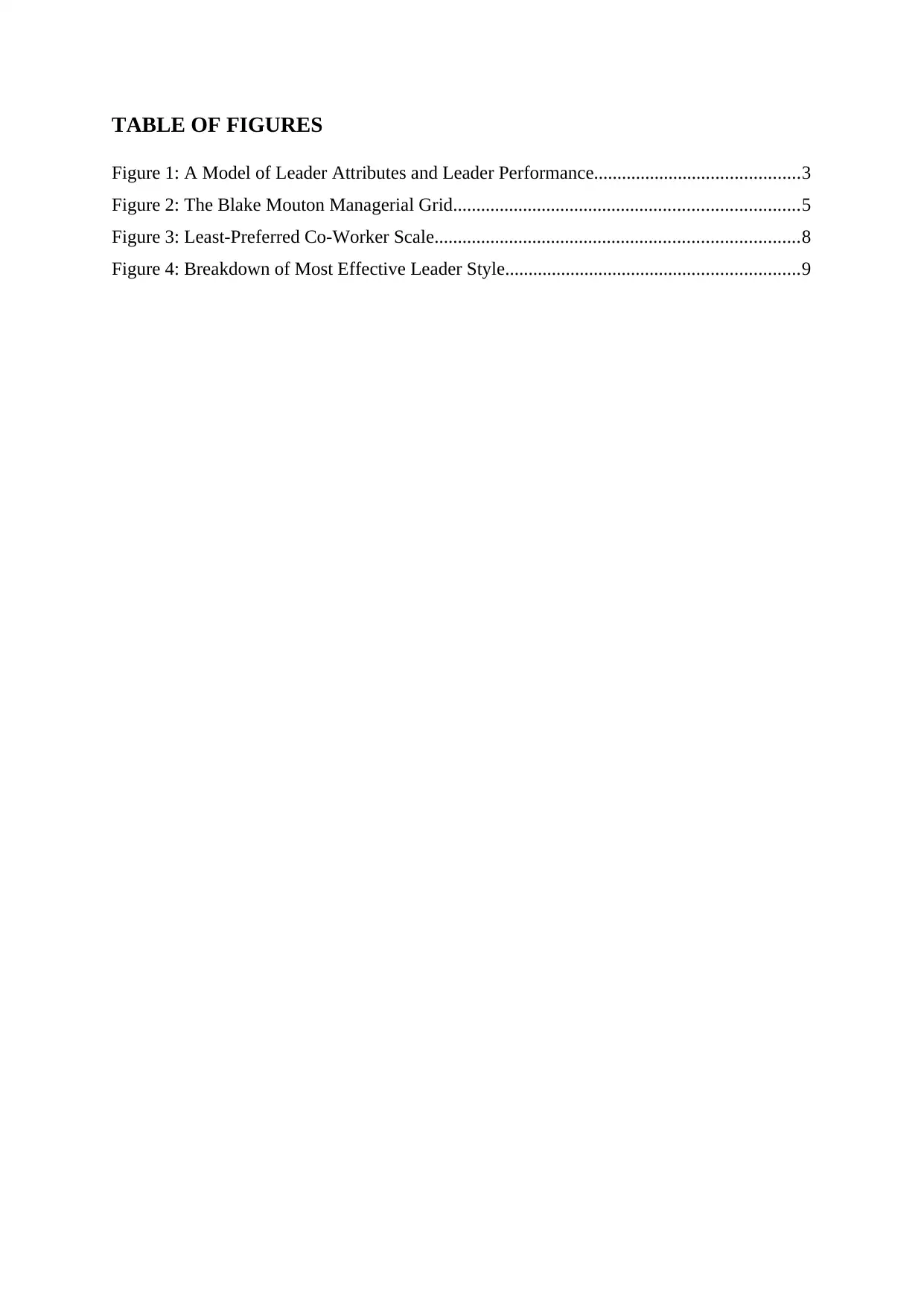
TABLE OF FIGURES
Figure 1: A Model of Leader Attributes and Leader Performance............................................3
Figure 2: The Blake Mouton Managerial Grid..........................................................................5
Figure 3: Least-Preferred Co-Worker Scale..............................................................................8
Figure 4: Breakdown of Most Effective Leader Style...............................................................9
Figure 1: A Model of Leader Attributes and Leader Performance............................................3
Figure 2: The Blake Mouton Managerial Grid..........................................................................5
Figure 3: Least-Preferred Co-Worker Scale..............................................................................8
Figure 4: Breakdown of Most Effective Leader Style...............................................................9
⊘ This is a preview!⊘
Do you want full access?
Subscribe today to unlock all pages.

Trusted by 1+ million students worldwide
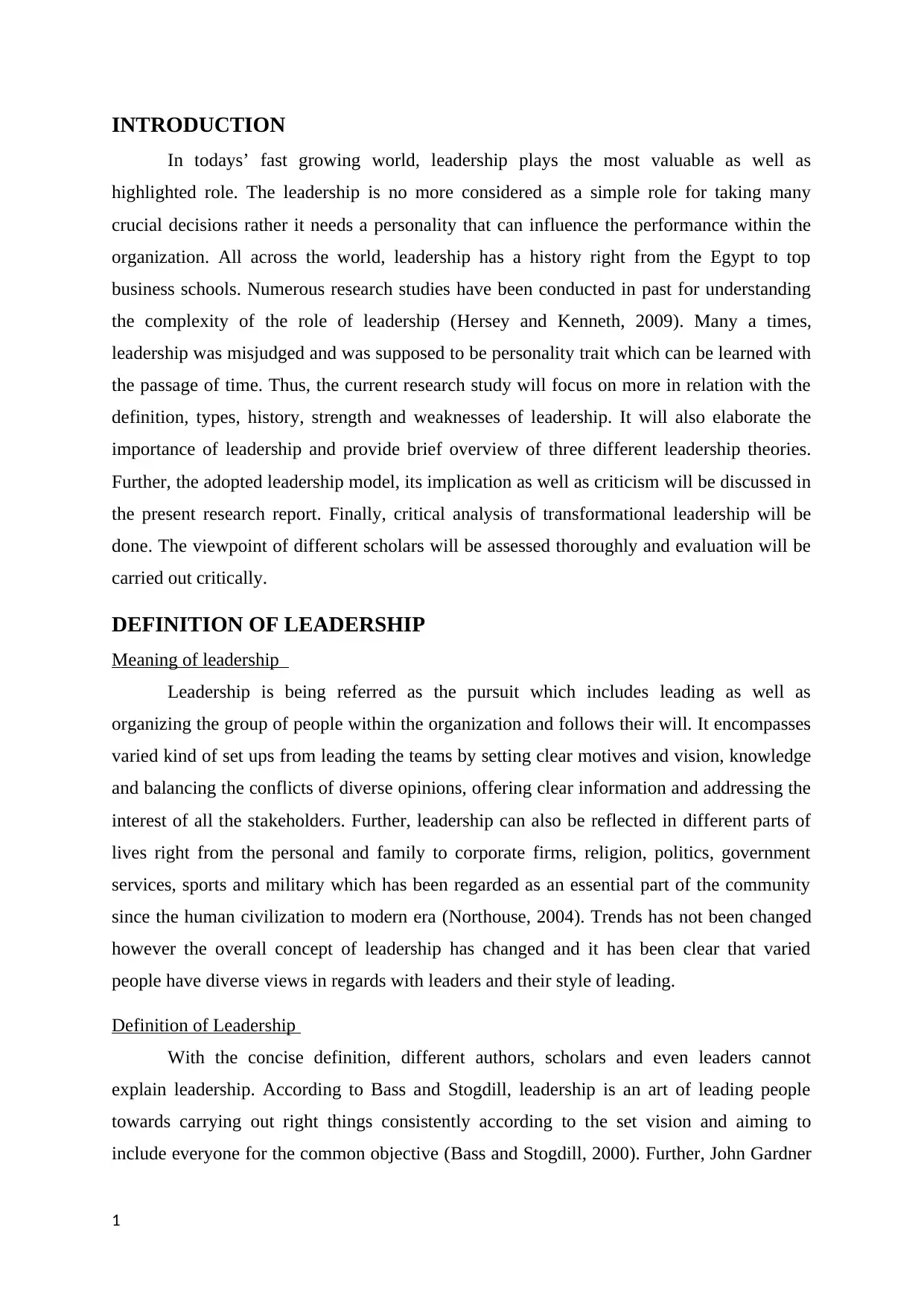
INTRODUCTION
In todays’ fast growing world, leadership plays the most valuable as well as
highlighted role. The leadership is no more considered as a simple role for taking many
crucial decisions rather it needs a personality that can influence the performance within the
organization. All across the world, leadership has a history right from the Egypt to top
business schools. Numerous research studies have been conducted in past for understanding
the complexity of the role of leadership (Hersey and Kenneth, 2009). Many a times,
leadership was misjudged and was supposed to be personality trait which can be learned with
the passage of time. Thus, the current research study will focus on more in relation with the
definition, types, history, strength and weaknesses of leadership. It will also elaborate the
importance of leadership and provide brief overview of three different leadership theories.
Further, the adopted leadership model, its implication as well as criticism will be discussed in
the present research report. Finally, critical analysis of transformational leadership will be
done. The viewpoint of different scholars will be assessed thoroughly and evaluation will be
carried out critically.
DEFINITION OF LEADERSHIP
Meaning of leadership
Leadership is being referred as the pursuit which includes leading as well as
organizing the group of people within the organization and follows their will. It encompasses
varied kind of set ups from leading the teams by setting clear motives and vision, knowledge
and balancing the conflicts of diverse opinions, offering clear information and addressing the
interest of all the stakeholders. Further, leadership can also be reflected in different parts of
lives right from the personal and family to corporate firms, religion, politics, government
services, sports and military which has been regarded as an essential part of the community
since the human civilization to modern era (Northouse, 2004). Trends has not been changed
however the overall concept of leadership has changed and it has been clear that varied
people have diverse views in regards with leaders and their style of leading.
Definition of Leadership
With the concise definition, different authors, scholars and even leaders cannot
explain leadership. According to Bass and Stogdill, leadership is an art of leading people
towards carrying out right things consistently according to the set vision and aiming to
include everyone for the common objective (Bass and Stogdill, 2000). Further, John Gardner
1
In todays’ fast growing world, leadership plays the most valuable as well as
highlighted role. The leadership is no more considered as a simple role for taking many
crucial decisions rather it needs a personality that can influence the performance within the
organization. All across the world, leadership has a history right from the Egypt to top
business schools. Numerous research studies have been conducted in past for understanding
the complexity of the role of leadership (Hersey and Kenneth, 2009). Many a times,
leadership was misjudged and was supposed to be personality trait which can be learned with
the passage of time. Thus, the current research study will focus on more in relation with the
definition, types, history, strength and weaknesses of leadership. It will also elaborate the
importance of leadership and provide brief overview of three different leadership theories.
Further, the adopted leadership model, its implication as well as criticism will be discussed in
the present research report. Finally, critical analysis of transformational leadership will be
done. The viewpoint of different scholars will be assessed thoroughly and evaluation will be
carried out critically.
DEFINITION OF LEADERSHIP
Meaning of leadership
Leadership is being referred as the pursuit which includes leading as well as
organizing the group of people within the organization and follows their will. It encompasses
varied kind of set ups from leading the teams by setting clear motives and vision, knowledge
and balancing the conflicts of diverse opinions, offering clear information and addressing the
interest of all the stakeholders. Further, leadership can also be reflected in different parts of
lives right from the personal and family to corporate firms, religion, politics, government
services, sports and military which has been regarded as an essential part of the community
since the human civilization to modern era (Northouse, 2004). Trends has not been changed
however the overall concept of leadership has changed and it has been clear that varied
people have diverse views in regards with leaders and their style of leading.
Definition of Leadership
With the concise definition, different authors, scholars and even leaders cannot
explain leadership. According to Bass and Stogdill, leadership is an art of leading people
towards carrying out right things consistently according to the set vision and aiming to
include everyone for the common objective (Bass and Stogdill, 2000). Further, John Gardner
1
Paraphrase This Document
Need a fresh take? Get an instant paraphrase of this document with our AI Paraphraser
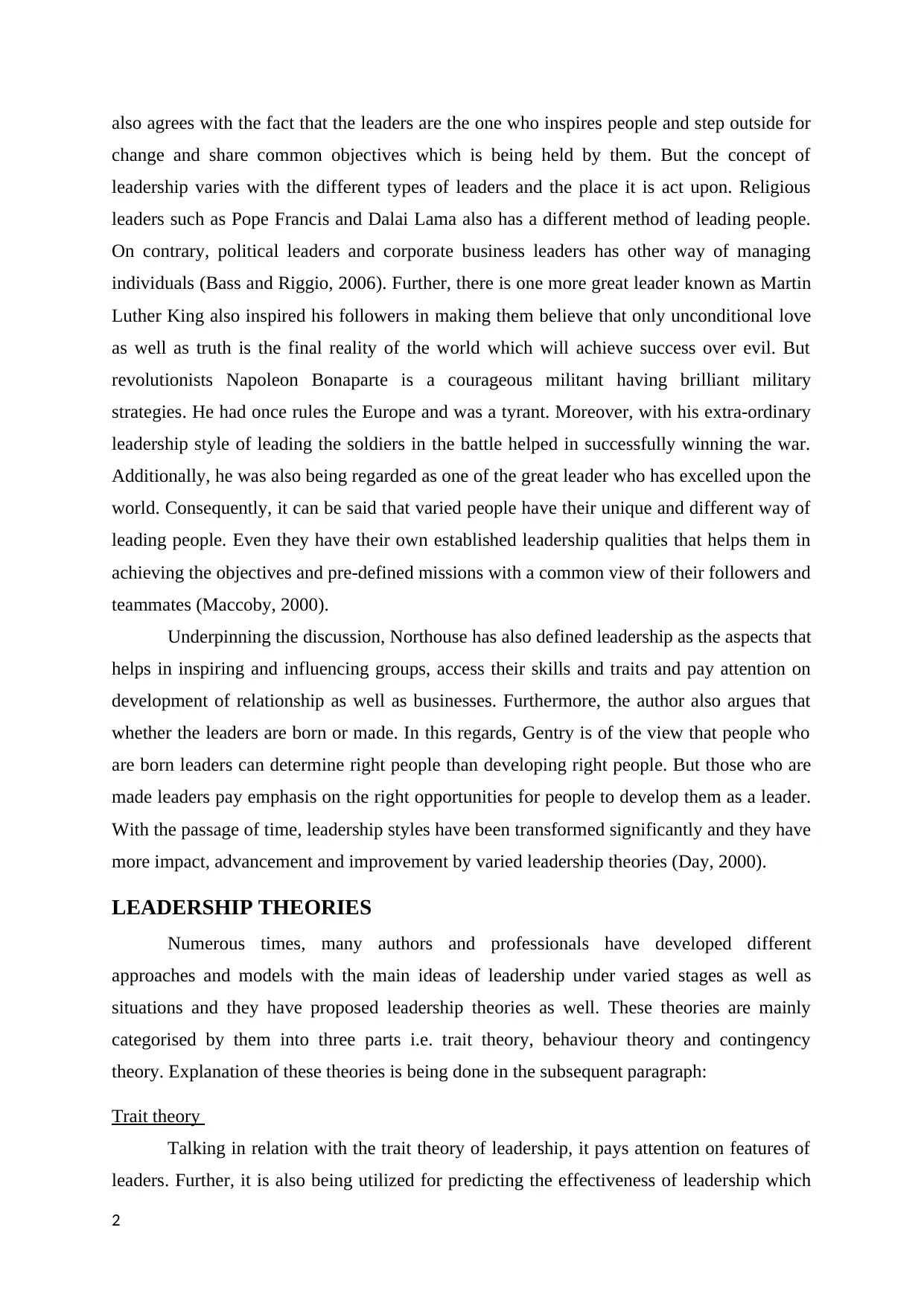
also agrees with the fact that the leaders are the one who inspires people and step outside for
change and share common objectives which is being held by them. But the concept of
leadership varies with the different types of leaders and the place it is act upon. Religious
leaders such as Pope Francis and Dalai Lama also has a different method of leading people.
On contrary, political leaders and corporate business leaders has other way of managing
individuals (Bass and Riggio, 2006). Further, there is one more great leader known as Martin
Luther King also inspired his followers in making them believe that only unconditional love
as well as truth is the final reality of the world which will achieve success over evil. But
revolutionists Napoleon Bonaparte is a courageous militant having brilliant military
strategies. He had once rules the Europe and was a tyrant. Moreover, with his extra-ordinary
leadership style of leading the soldiers in the battle helped in successfully winning the war.
Additionally, he was also being regarded as one of the great leader who has excelled upon the
world. Consequently, it can be said that varied people have their unique and different way of
leading people. Even they have their own established leadership qualities that helps them in
achieving the objectives and pre-defined missions with a common view of their followers and
teammates (Maccoby, 2000).
Underpinning the discussion, Northouse has also defined leadership as the aspects that
helps in inspiring and influencing groups, access their skills and traits and pay attention on
development of relationship as well as businesses. Furthermore, the author also argues that
whether the leaders are born or made. In this regards, Gentry is of the view that people who
are born leaders can determine right people than developing right people. But those who are
made leaders pay emphasis on the right opportunities for people to develop them as a leader.
With the passage of time, leadership styles have been transformed significantly and they have
more impact, advancement and improvement by varied leadership theories (Day, 2000).
LEADERSHIP THEORIES
Numerous times, many authors and professionals have developed different
approaches and models with the main ideas of leadership under varied stages as well as
situations and they have proposed leadership theories as well. These theories are mainly
categorised by them into three parts i.e. trait theory, behaviour theory and contingency
theory. Explanation of these theories is being done in the subsequent paragraph:
Trait theory
Talking in relation with the trait theory of leadership, it pays attention on features of
leaders. Further, it is also being utilized for predicting the effectiveness of leadership which
2
change and share common objectives which is being held by them. But the concept of
leadership varies with the different types of leaders and the place it is act upon. Religious
leaders such as Pope Francis and Dalai Lama also has a different method of leading people.
On contrary, political leaders and corporate business leaders has other way of managing
individuals (Bass and Riggio, 2006). Further, there is one more great leader known as Martin
Luther King also inspired his followers in making them believe that only unconditional love
as well as truth is the final reality of the world which will achieve success over evil. But
revolutionists Napoleon Bonaparte is a courageous militant having brilliant military
strategies. He had once rules the Europe and was a tyrant. Moreover, with his extra-ordinary
leadership style of leading the soldiers in the battle helped in successfully winning the war.
Additionally, he was also being regarded as one of the great leader who has excelled upon the
world. Consequently, it can be said that varied people have their unique and different way of
leading people. Even they have their own established leadership qualities that helps them in
achieving the objectives and pre-defined missions with a common view of their followers and
teammates (Maccoby, 2000).
Underpinning the discussion, Northouse has also defined leadership as the aspects that
helps in inspiring and influencing groups, access their skills and traits and pay attention on
development of relationship as well as businesses. Furthermore, the author also argues that
whether the leaders are born or made. In this regards, Gentry is of the view that people who
are born leaders can determine right people than developing right people. But those who are
made leaders pay emphasis on the right opportunities for people to develop them as a leader.
With the passage of time, leadership styles have been transformed significantly and they have
more impact, advancement and improvement by varied leadership theories (Day, 2000).
LEADERSHIP THEORIES
Numerous times, many authors and professionals have developed different
approaches and models with the main ideas of leadership under varied stages as well as
situations and they have proposed leadership theories as well. These theories are mainly
categorised by them into three parts i.e. trait theory, behaviour theory and contingency
theory. Explanation of these theories is being done in the subsequent paragraph:
Trait theory
Talking in relation with the trait theory of leadership, it pays attention on features of
leaders. Further, it is also being utilized for predicting the effectiveness of leadership which
2
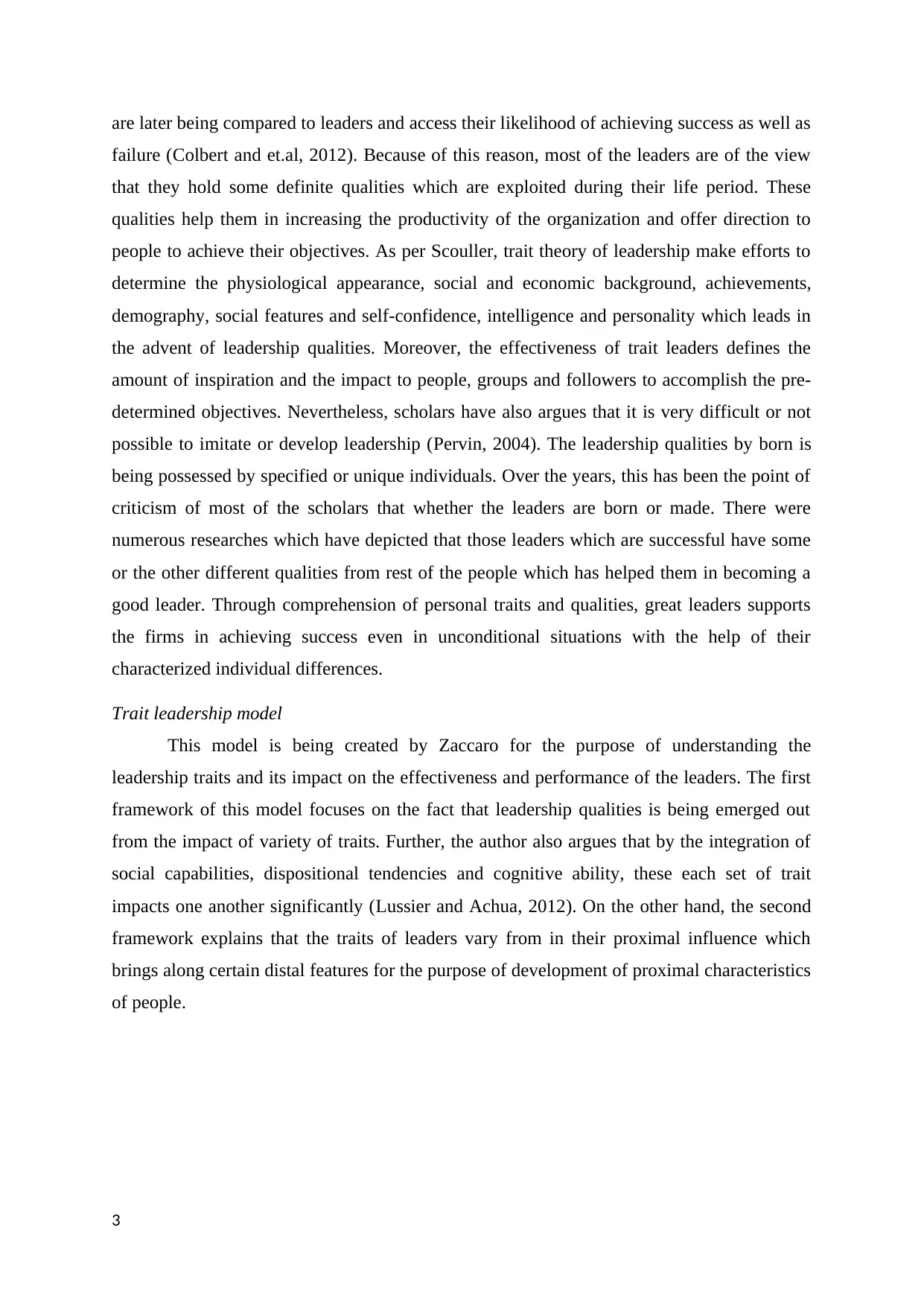
are later being compared to leaders and access their likelihood of achieving success as well as
failure (Colbert and et.al, 2012). Because of this reason, most of the leaders are of the view
that they hold some definite qualities which are exploited during their life period. These
qualities help them in increasing the productivity of the organization and offer direction to
people to achieve their objectives. As per Scouller, trait theory of leadership make efforts to
determine the physiological appearance, social and economic background, achievements,
demography, social features and self-confidence, intelligence and personality which leads in
the advent of leadership qualities. Moreover, the effectiveness of trait leaders defines the
amount of inspiration and the impact to people, groups and followers to accomplish the pre-
determined objectives. Nevertheless, scholars have also argues that it is very difficult or not
possible to imitate or develop leadership (Pervin, 2004). The leadership qualities by born is
being possessed by specified or unique individuals. Over the years, this has been the point of
criticism of most of the scholars that whether the leaders are born or made. There were
numerous researches which have depicted that those leaders which are successful have some
or the other different qualities from rest of the people which has helped them in becoming a
good leader. Through comprehension of personal traits and qualities, great leaders supports
the firms in achieving success even in unconditional situations with the help of their
characterized individual differences.
Trait leadership model
This model is being created by Zaccaro for the purpose of understanding the
leadership traits and its impact on the effectiveness and performance of the leaders. The first
framework of this model focuses on the fact that leadership qualities is being emerged out
from the impact of variety of traits. Further, the author also argues that by the integration of
social capabilities, dispositional tendencies and cognitive ability, these each set of trait
impacts one another significantly (Lussier and Achua, 2012). On the other hand, the second
framework explains that the traits of leaders vary from in their proximal influence which
brings along certain distal features for the purpose of development of proximal characteristics
of people.
3
failure (Colbert and et.al, 2012). Because of this reason, most of the leaders are of the view
that they hold some definite qualities which are exploited during their life period. These
qualities help them in increasing the productivity of the organization and offer direction to
people to achieve their objectives. As per Scouller, trait theory of leadership make efforts to
determine the physiological appearance, social and economic background, achievements,
demography, social features and self-confidence, intelligence and personality which leads in
the advent of leadership qualities. Moreover, the effectiveness of trait leaders defines the
amount of inspiration and the impact to people, groups and followers to accomplish the pre-
determined objectives. Nevertheless, scholars have also argues that it is very difficult or not
possible to imitate or develop leadership (Pervin, 2004). The leadership qualities by born is
being possessed by specified or unique individuals. Over the years, this has been the point of
criticism of most of the scholars that whether the leaders are born or made. There were
numerous researches which have depicted that those leaders which are successful have some
or the other different qualities from rest of the people which has helped them in becoming a
good leader. Through comprehension of personal traits and qualities, great leaders supports
the firms in achieving success even in unconditional situations with the help of their
characterized individual differences.
Trait leadership model
This model is being created by Zaccaro for the purpose of understanding the
leadership traits and its impact on the effectiveness and performance of the leaders. The first
framework of this model focuses on the fact that leadership qualities is being emerged out
from the impact of variety of traits. Further, the author also argues that by the integration of
social capabilities, dispositional tendencies and cognitive ability, these each set of trait
impacts one another significantly (Lussier and Achua, 2012). On the other hand, the second
framework explains that the traits of leaders vary from in their proximal influence which
brings along certain distal features for the purpose of development of proximal characteristics
of people.
3
⊘ This is a preview!⊘
Do you want full access?
Subscribe today to unlock all pages.

Trusted by 1+ million students worldwide
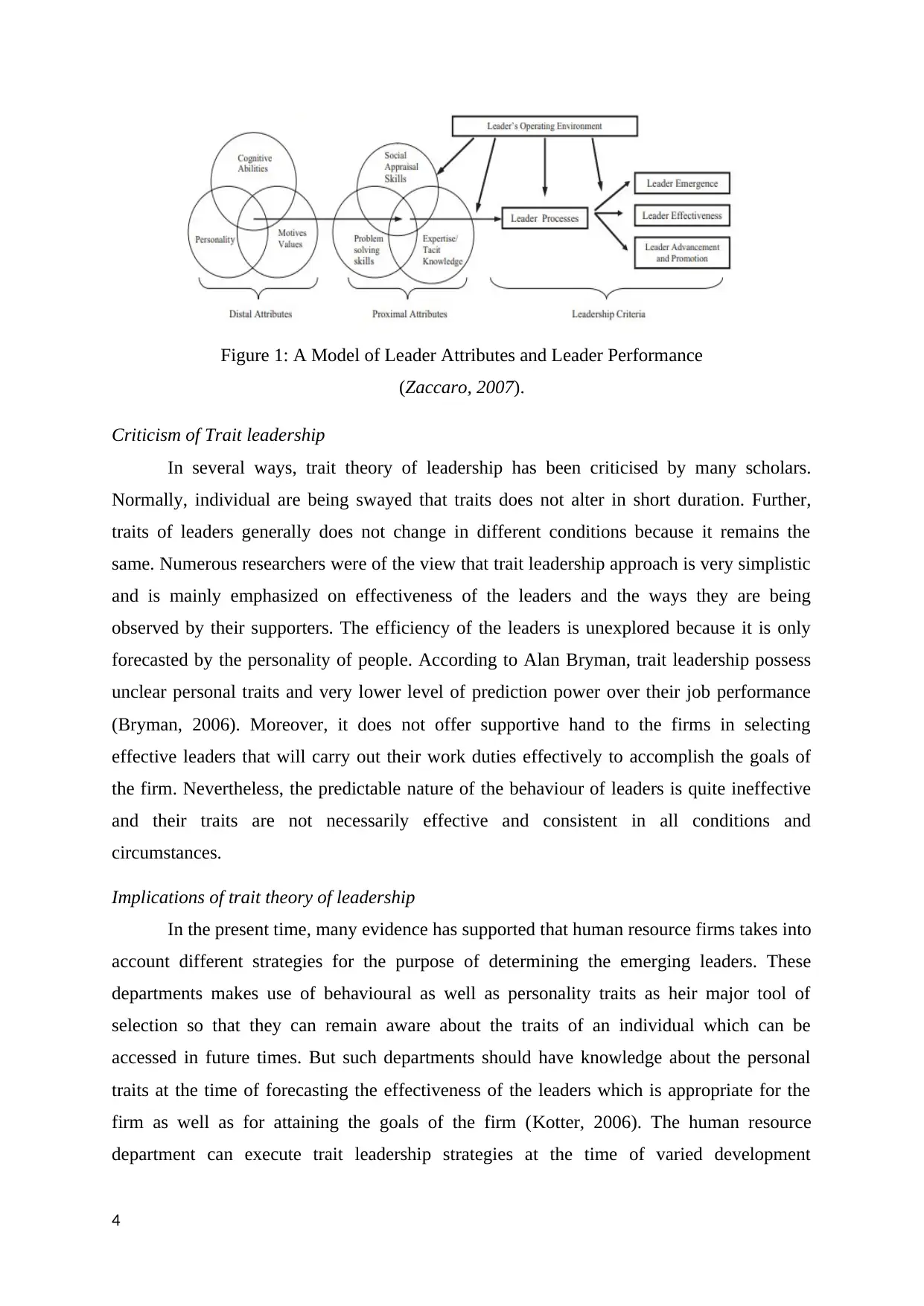
Figure 1: A Model of Leader Attributes and Leader Performance
(Zaccaro, 2007).
Criticism of Trait leadership
In several ways, trait theory of leadership has been criticised by many scholars.
Normally, individual are being swayed that traits does not alter in short duration. Further,
traits of leaders generally does not change in different conditions because it remains the
same. Numerous researchers were of the view that trait leadership approach is very simplistic
and is mainly emphasized on effectiveness of the leaders and the ways they are being
observed by their supporters. The efficiency of the leaders is unexplored because it is only
forecasted by the personality of people. According to Alan Bryman, trait leadership possess
unclear personal traits and very lower level of prediction power over their job performance
(Bryman, 2006). Moreover, it does not offer supportive hand to the firms in selecting
effective leaders that will carry out their work duties effectively to accomplish the goals of
the firm. Nevertheless, the predictable nature of the behaviour of leaders is quite ineffective
and their traits are not necessarily effective and consistent in all conditions and
circumstances.
Implications of trait theory of leadership
In the present time, many evidence has supported that human resource firms takes into
account different strategies for the purpose of determining the emerging leaders. These
departments makes use of behavioural as well as personality traits as heir major tool of
selection so that they can remain aware about the traits of an individual which can be
accessed in future times. But such departments should have knowledge about the personal
traits at the time of forecasting the effectiveness of the leaders which is appropriate for the
firm as well as for attaining the goals of the firm (Kotter, 2006). The human resource
department can execute trait leadership strategies at the time of varied development
4
(Zaccaro, 2007).
Criticism of Trait leadership
In several ways, trait theory of leadership has been criticised by many scholars.
Normally, individual are being swayed that traits does not alter in short duration. Further,
traits of leaders generally does not change in different conditions because it remains the
same. Numerous researchers were of the view that trait leadership approach is very simplistic
and is mainly emphasized on effectiveness of the leaders and the ways they are being
observed by their supporters. The efficiency of the leaders is unexplored because it is only
forecasted by the personality of people. According to Alan Bryman, trait leadership possess
unclear personal traits and very lower level of prediction power over their job performance
(Bryman, 2006). Moreover, it does not offer supportive hand to the firms in selecting
effective leaders that will carry out their work duties effectively to accomplish the goals of
the firm. Nevertheless, the predictable nature of the behaviour of leaders is quite ineffective
and their traits are not necessarily effective and consistent in all conditions and
circumstances.
Implications of trait theory of leadership
In the present time, many evidence has supported that human resource firms takes into
account different strategies for the purpose of determining the emerging leaders. These
departments makes use of behavioural as well as personality traits as heir major tool of
selection so that they can remain aware about the traits of an individual which can be
accessed in future times. But such departments should have knowledge about the personal
traits at the time of forecasting the effectiveness of the leaders which is appropriate for the
firm as well as for attaining the goals of the firm (Kotter, 2006). The human resource
department can execute trait leadership strategies at the time of varied development
4
Paraphrase This Document
Need a fresh take? Get an instant paraphrase of this document with our AI Paraphraser
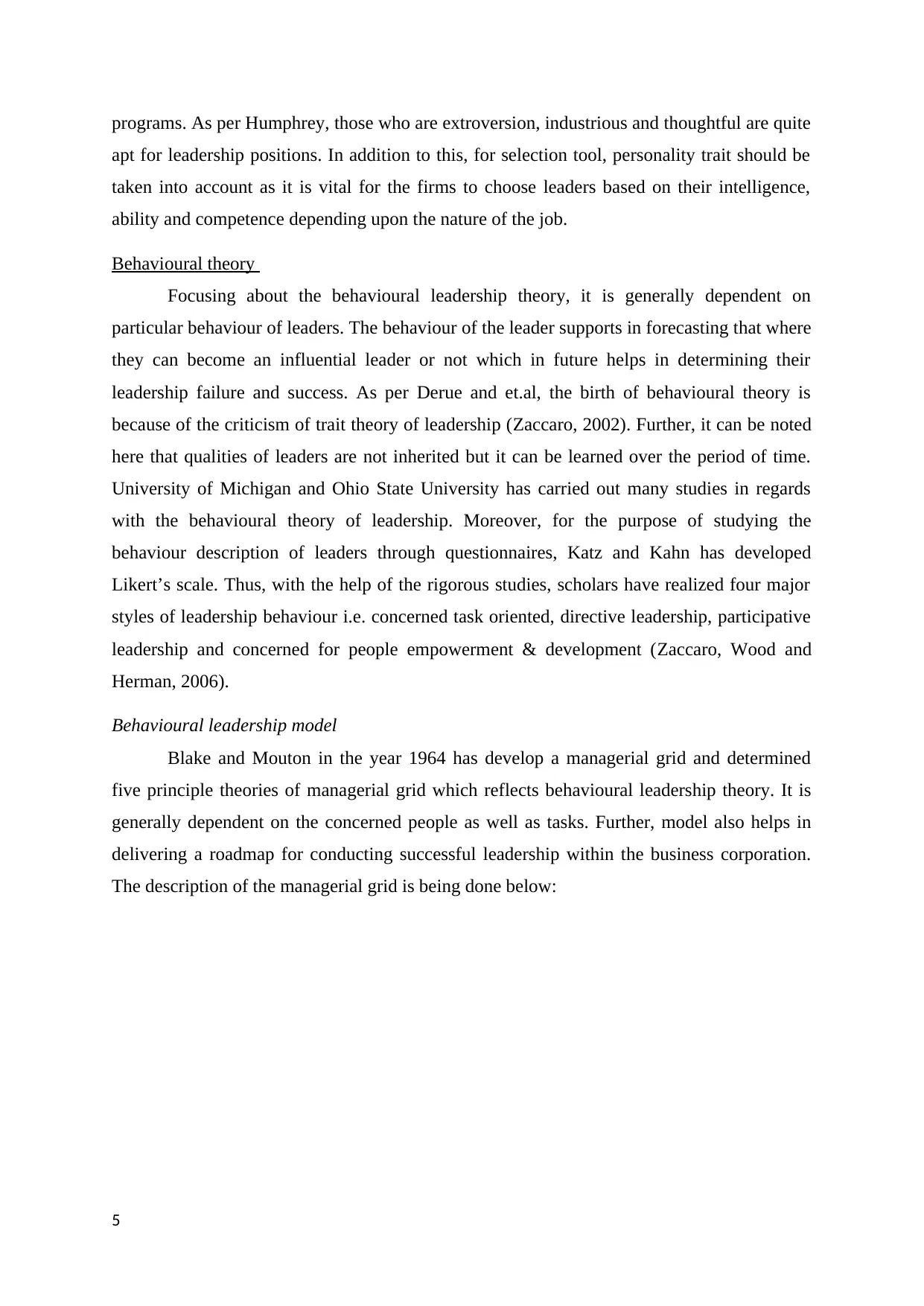
programs. As per Humphrey, those who are extroversion, industrious and thoughtful are quite
apt for leadership positions. In addition to this, for selection tool, personality trait should be
taken into account as it is vital for the firms to choose leaders based on their intelligence,
ability and competence depending upon the nature of the job.
Behavioural theory
Focusing about the behavioural leadership theory, it is generally dependent on
particular behaviour of leaders. The behaviour of the leader supports in forecasting that where
they can become an influential leader or not which in future helps in determining their
leadership failure and success. As per Derue and et.al, the birth of behavioural theory is
because of the criticism of trait theory of leadership (Zaccaro, 2002). Further, it can be noted
here that qualities of leaders are not inherited but it can be learned over the period of time.
University of Michigan and Ohio State University has carried out many studies in regards
with the behavioural theory of leadership. Moreover, for the purpose of studying the
behaviour description of leaders through questionnaires, Katz and Kahn has developed
Likert’s scale. Thus, with the help of the rigorous studies, scholars have realized four major
styles of leadership behaviour i.e. concerned task oriented, directive leadership, participative
leadership and concerned for people empowerment & development (Zaccaro, Wood and
Herman, 2006).
Behavioural leadership model
Blake and Mouton in the year 1964 has develop a managerial grid and determined
five principle theories of managerial grid which reflects behavioural leadership theory. It is
generally dependent on the concerned people as well as tasks. Further, model also helps in
delivering a roadmap for conducting successful leadership within the business corporation.
The description of the managerial grid is being done below:
5
apt for leadership positions. In addition to this, for selection tool, personality trait should be
taken into account as it is vital for the firms to choose leaders based on their intelligence,
ability and competence depending upon the nature of the job.
Behavioural theory
Focusing about the behavioural leadership theory, it is generally dependent on
particular behaviour of leaders. The behaviour of the leader supports in forecasting that where
they can become an influential leader or not which in future helps in determining their
leadership failure and success. As per Derue and et.al, the birth of behavioural theory is
because of the criticism of trait theory of leadership (Zaccaro, 2002). Further, it can be noted
here that qualities of leaders are not inherited but it can be learned over the period of time.
University of Michigan and Ohio State University has carried out many studies in regards
with the behavioural theory of leadership. Moreover, for the purpose of studying the
behaviour description of leaders through questionnaires, Katz and Kahn has developed
Likert’s scale. Thus, with the help of the rigorous studies, scholars have realized four major
styles of leadership behaviour i.e. concerned task oriented, directive leadership, participative
leadership and concerned for people empowerment & development (Zaccaro, Wood and
Herman, 2006).
Behavioural leadership model
Blake and Mouton in the year 1964 has develop a managerial grid and determined
five principle theories of managerial grid which reflects behavioural leadership theory. It is
generally dependent on the concerned people as well as tasks. Further, model also helps in
delivering a roadmap for conducting successful leadership within the business corporation.
The description of the managerial grid is being done below:
5
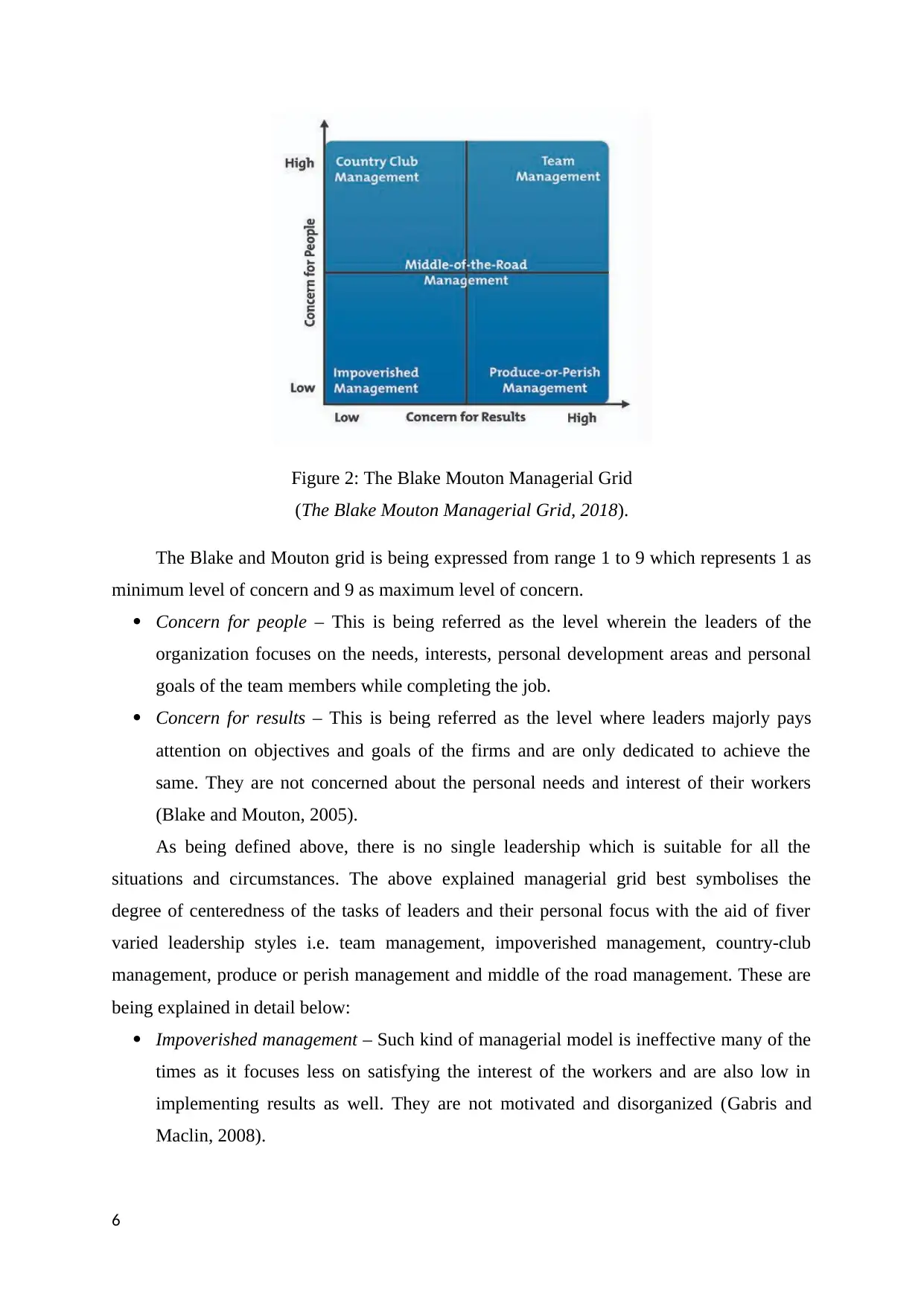
Figure 2: The Blake Mouton Managerial Grid
(The Blake Mouton Managerial Grid, 2018).
The Blake and Mouton grid is being expressed from range 1 to 9 which represents 1 as
minimum level of concern and 9 as maximum level of concern.
Concern for people – This is being referred as the level wherein the leaders of the
organization focuses on the needs, interests, personal development areas and personal
goals of the team members while completing the job.
Concern for results – This is being referred as the level where leaders majorly pays
attention on objectives and goals of the firms and are only dedicated to achieve the
same. They are not concerned about the personal needs and interest of their workers
(Blake and Mouton, 2005).
As being defined above, there is no single leadership which is suitable for all the
situations and circumstances. The above explained managerial grid best symbolises the
degree of centeredness of the tasks of leaders and their personal focus with the aid of fiver
varied leadership styles i.e. team management, impoverished management, country-club
management, produce or perish management and middle of the road management. These are
being explained in detail below:
Impoverished management – Such kind of managerial model is ineffective many of the
times as it focuses less on satisfying the interest of the workers and are also low in
implementing results as well. They are not motivated and disorganized (Gabris and
Maclin, 2008).
6
(The Blake Mouton Managerial Grid, 2018).
The Blake and Mouton grid is being expressed from range 1 to 9 which represents 1 as
minimum level of concern and 9 as maximum level of concern.
Concern for people – This is being referred as the level wherein the leaders of the
organization focuses on the needs, interests, personal development areas and personal
goals of the team members while completing the job.
Concern for results – This is being referred as the level where leaders majorly pays
attention on objectives and goals of the firms and are only dedicated to achieve the
same. They are not concerned about the personal needs and interest of their workers
(Blake and Mouton, 2005).
As being defined above, there is no single leadership which is suitable for all the
situations and circumstances. The above explained managerial grid best symbolises the
degree of centeredness of the tasks of leaders and their personal focus with the aid of fiver
varied leadership styles i.e. team management, impoverished management, country-club
management, produce or perish management and middle of the road management. These are
being explained in detail below:
Impoverished management – Such kind of managerial model is ineffective many of the
times as it focuses less on satisfying the interest of the workers and are also low in
implementing results as well. They are not motivated and disorganized (Gabris and
Maclin, 2008).
6
⊘ This is a preview!⊘
Do you want full access?
Subscribe today to unlock all pages.

Trusted by 1+ million students worldwide
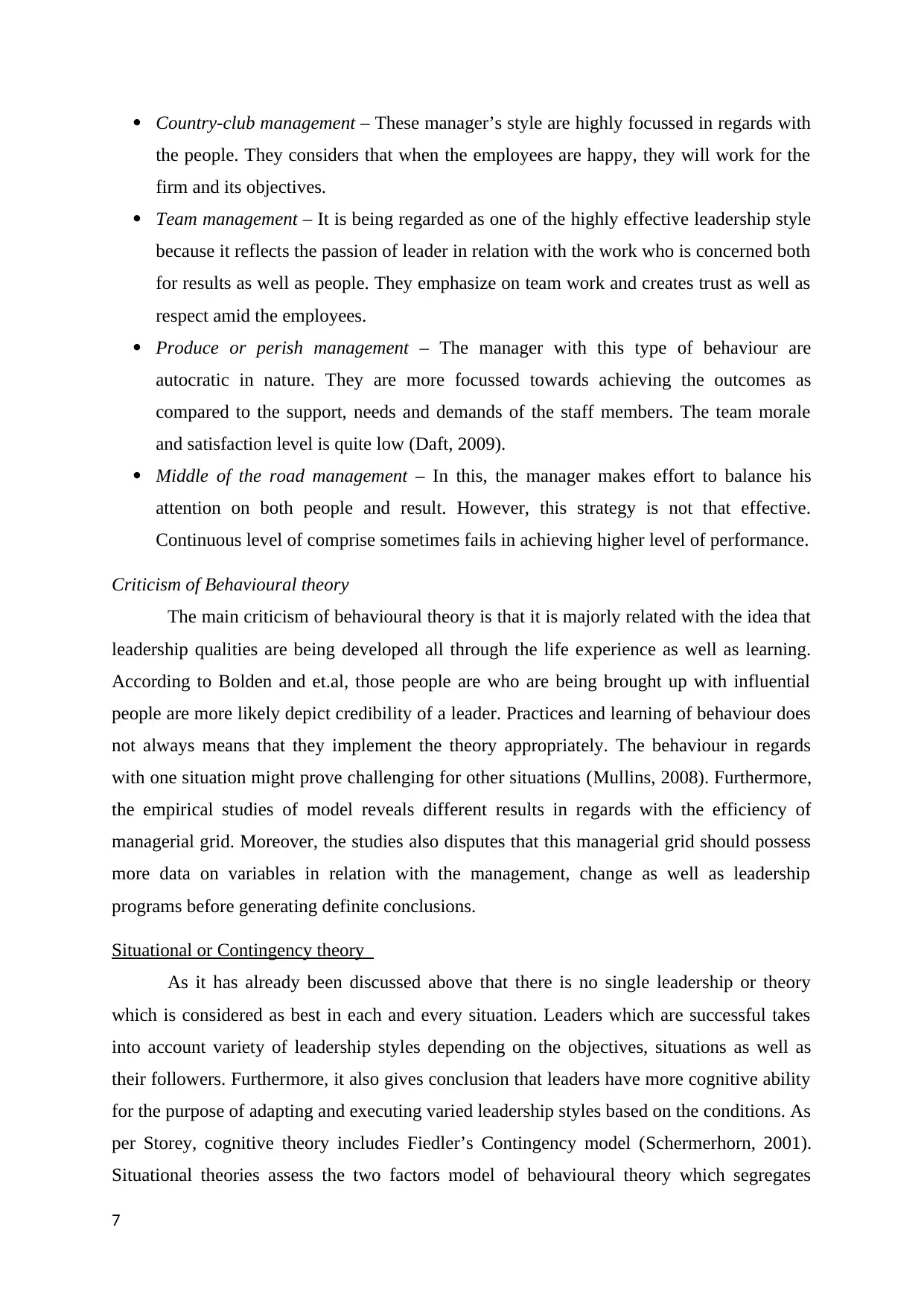
Country-club management – These manager’s style are highly focussed in regards with
the people. They considers that when the employees are happy, they will work for the
firm and its objectives.
Team management – It is being regarded as one of the highly effective leadership style
because it reflects the passion of leader in relation with the work who is concerned both
for results as well as people. They emphasize on team work and creates trust as well as
respect amid the employees.
Produce or perish management – The manager with this type of behaviour are
autocratic in nature. They are more focussed towards achieving the outcomes as
compared to the support, needs and demands of the staff members. The team morale
and satisfaction level is quite low (Daft, 2009).
Middle of the road management – In this, the manager makes effort to balance his
attention on both people and result. However, this strategy is not that effective.
Continuous level of comprise sometimes fails in achieving higher level of performance.
Criticism of Behavioural theory
The main criticism of behavioural theory is that it is majorly related with the idea that
leadership qualities are being developed all through the life experience as well as learning.
According to Bolden and et.al, those people are who are being brought up with influential
people are more likely depict credibility of a leader. Practices and learning of behaviour does
not always means that they implement the theory appropriately. The behaviour in regards
with one situation might prove challenging for other situations (Mullins, 2008). Furthermore,
the empirical studies of model reveals different results in regards with the efficiency of
managerial grid. Moreover, the studies also disputes that this managerial grid should possess
more data on variables in relation with the management, change as well as leadership
programs before generating definite conclusions.
Situational or Contingency theory
As it has already been discussed above that there is no single leadership or theory
which is considered as best in each and every situation. Leaders which are successful takes
into account variety of leadership styles depending on the objectives, situations as well as
their followers. Furthermore, it also gives conclusion that leaders have more cognitive ability
for the purpose of adapting and executing varied leadership styles based on the conditions. As
per Storey, cognitive theory includes Fiedler’s Contingency model (Schermerhorn, 2001).
Situational theories assess the two factors model of behavioural theory which segregates
7
the people. They considers that when the employees are happy, they will work for the
firm and its objectives.
Team management – It is being regarded as one of the highly effective leadership style
because it reflects the passion of leader in relation with the work who is concerned both
for results as well as people. They emphasize on team work and creates trust as well as
respect amid the employees.
Produce or perish management – The manager with this type of behaviour are
autocratic in nature. They are more focussed towards achieving the outcomes as
compared to the support, needs and demands of the staff members. The team morale
and satisfaction level is quite low (Daft, 2009).
Middle of the road management – In this, the manager makes effort to balance his
attention on both people and result. However, this strategy is not that effective.
Continuous level of comprise sometimes fails in achieving higher level of performance.
Criticism of Behavioural theory
The main criticism of behavioural theory is that it is majorly related with the idea that
leadership qualities are being developed all through the life experience as well as learning.
According to Bolden and et.al, those people are who are being brought up with influential
people are more likely depict credibility of a leader. Practices and learning of behaviour does
not always means that they implement the theory appropriately. The behaviour in regards
with one situation might prove challenging for other situations (Mullins, 2008). Furthermore,
the empirical studies of model reveals different results in regards with the efficiency of
managerial grid. Moreover, the studies also disputes that this managerial grid should possess
more data on variables in relation with the management, change as well as leadership
programs before generating definite conclusions.
Situational or Contingency theory
As it has already been discussed above that there is no single leadership or theory
which is considered as best in each and every situation. Leaders which are successful takes
into account variety of leadership styles depending on the objectives, situations as well as
their followers. Furthermore, it also gives conclusion that leaders have more cognitive ability
for the purpose of adapting and executing varied leadership styles based on the conditions. As
per Storey, cognitive theory includes Fiedler’s Contingency model (Schermerhorn, 2001).
Situational theories assess the two factors model of behavioural theory which segregates
7
Paraphrase This Document
Need a fresh take? Get an instant paraphrase of this document with our AI Paraphraser
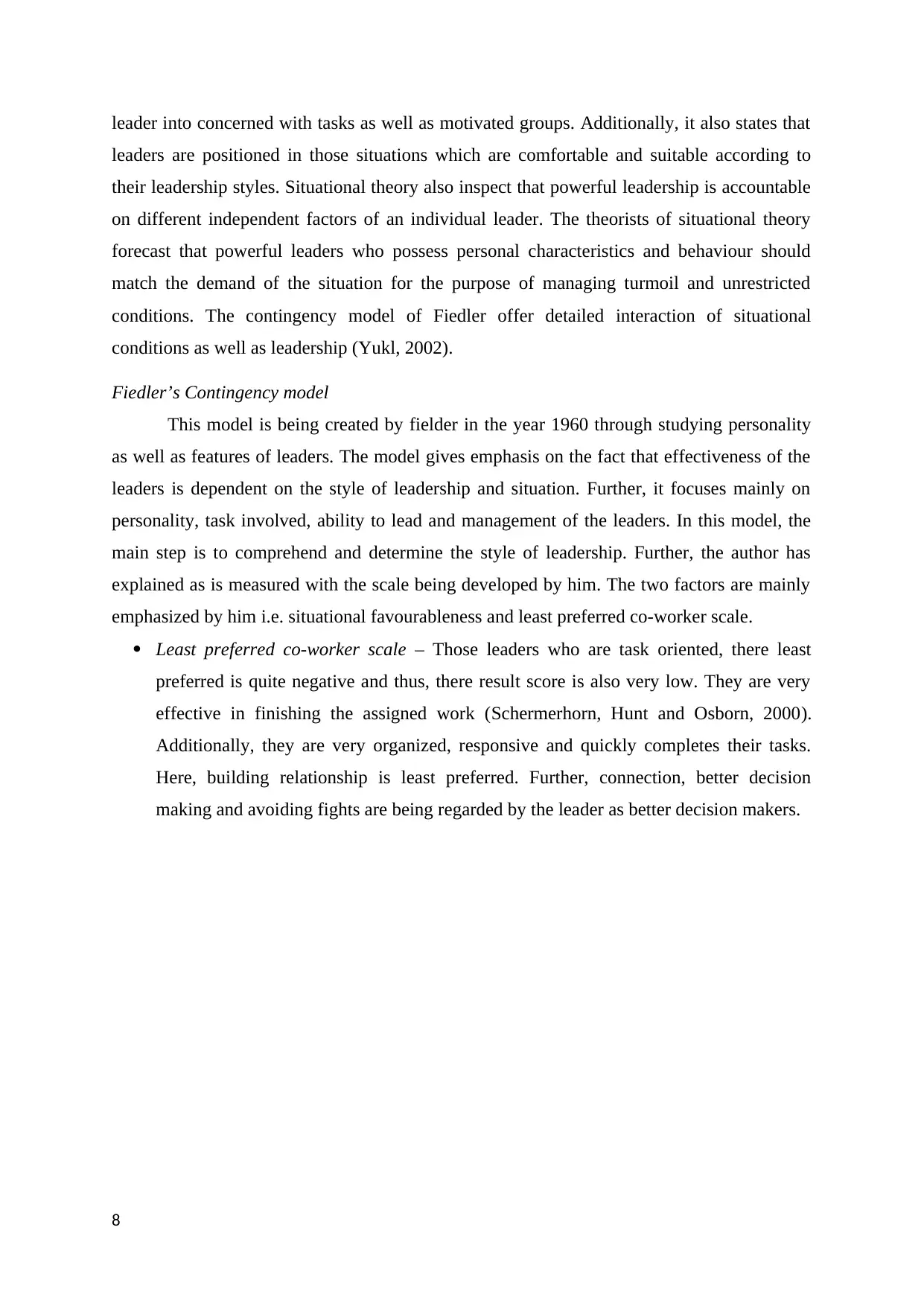
leader into concerned with tasks as well as motivated groups. Additionally, it also states that
leaders are positioned in those situations which are comfortable and suitable according to
their leadership styles. Situational theory also inspect that powerful leadership is accountable
on different independent factors of an individual leader. The theorists of situational theory
forecast that powerful leaders who possess personal characteristics and behaviour should
match the demand of the situation for the purpose of managing turmoil and unrestricted
conditions. The contingency model of Fiedler offer detailed interaction of situational
conditions as well as leadership (Yukl, 2002).
Fiedler’s Contingency model
This model is being created by fielder in the year 1960 through studying personality
as well as features of leaders. The model gives emphasis on the fact that effectiveness of the
leaders is dependent on the style of leadership and situation. Further, it focuses mainly on
personality, task involved, ability to lead and management of the leaders. In this model, the
main step is to comprehend and determine the style of leadership. Further, the author has
explained as is measured with the scale being developed by him. The two factors are mainly
emphasized by him i.e. situational favourableness and least preferred co-worker scale.
Least preferred co-worker scale – Those leaders who are task oriented, there least
preferred is quite negative and thus, there result score is also very low. They are very
effective in finishing the assigned work (Schermerhorn, Hunt and Osborn, 2000).
Additionally, they are very organized, responsive and quickly completes their tasks.
Here, building relationship is least preferred. Further, connection, better decision
making and avoiding fights are being regarded by the leader as better decision makers.
8
leaders are positioned in those situations which are comfortable and suitable according to
their leadership styles. Situational theory also inspect that powerful leadership is accountable
on different independent factors of an individual leader. The theorists of situational theory
forecast that powerful leaders who possess personal characteristics and behaviour should
match the demand of the situation for the purpose of managing turmoil and unrestricted
conditions. The contingency model of Fiedler offer detailed interaction of situational
conditions as well as leadership (Yukl, 2002).
Fiedler’s Contingency model
This model is being created by fielder in the year 1960 through studying personality
as well as features of leaders. The model gives emphasis on the fact that effectiveness of the
leaders is dependent on the style of leadership and situation. Further, it focuses mainly on
personality, task involved, ability to lead and management of the leaders. In this model, the
main step is to comprehend and determine the style of leadership. Further, the author has
explained as is measured with the scale being developed by him. The two factors are mainly
emphasized by him i.e. situational favourableness and least preferred co-worker scale.
Least preferred co-worker scale – Those leaders who are task oriented, there least
preferred is quite negative and thus, there result score is also very low. They are very
effective in finishing the assigned work (Schermerhorn, Hunt and Osborn, 2000).
Additionally, they are very organized, responsive and quickly completes their tasks.
Here, building relationship is least preferred. Further, connection, better decision
making and avoiding fights are being regarded by the leader as better decision makers.
8
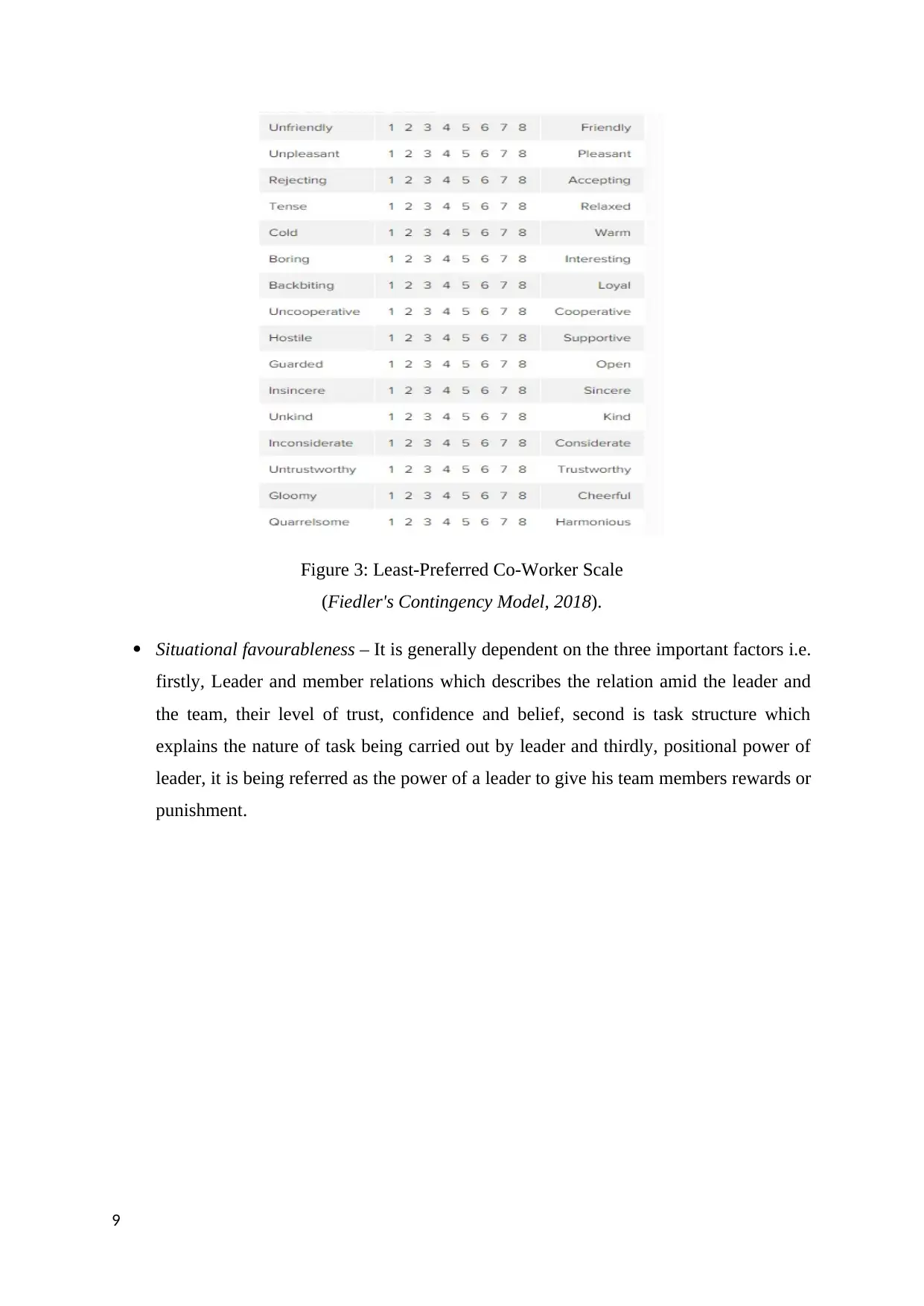
Figure 3: Least-Preferred Co-Worker Scale
(Fiedler's Contingency Model, 2018).
Situational favourableness – It is generally dependent on the three important factors i.e.
firstly, Leader and member relations which describes the relation amid the leader and
the team, their level of trust, confidence and belief, second is task structure which
explains the nature of task being carried out by leader and thirdly, positional power of
leader, it is being referred as the power of a leader to give his team members rewards or
punishment.
9
(Fiedler's Contingency Model, 2018).
Situational favourableness – It is generally dependent on the three important factors i.e.
firstly, Leader and member relations which describes the relation amid the leader and
the team, their level of trust, confidence and belief, second is task structure which
explains the nature of task being carried out by leader and thirdly, positional power of
leader, it is being referred as the power of a leader to give his team members rewards or
punishment.
9
⊘ This is a preview!⊘
Do you want full access?
Subscribe today to unlock all pages.

Trusted by 1+ million students worldwide
1 out of 19
Related Documents
Your All-in-One AI-Powered Toolkit for Academic Success.
+13062052269
info@desklib.com
Available 24*7 on WhatsApp / Email
![[object Object]](/_next/static/media/star-bottom.7253800d.svg)
Unlock your academic potential
Copyright © 2020–2025 A2Z Services. All Rights Reserved. Developed and managed by ZUCOL.




